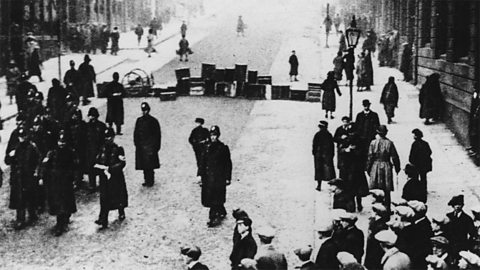Bloody Friday - Battle of George Square
The second phase of Red Clydeside took place just after the war ended. There were more strikes and conflict between workers and police, causing the government to worry that the strike leaders were preparing to start a revolution in Britain.
After the war, industrial workers across Britain began to fear for their jobs. They realised that the war had given a temporary boost to industries which had been facing problems before the war. As munitions factories closed, industrial workers also faced competition for jobs from thousands of returning soldiers.
Employment and race issues
On January 23rd violence broke out between groups of black and white sailors on Glasgowâs waterfront. With more men looking for work than there were jobs, the local white sailors saw the black sailors, many of whom had served in the British Merchant Navy and were citizens of the British Empire, as unwanted competition.
Around 30 black sailors were chased back to their lodgings on the Broomielaw by a much larger crowd of white sailors and other locals. Police broke up the fight, taking the black sailors into custody. Two white and one black man were injured. 27 black sailors had all charges against them dropped. Three were fined for breach of the peace.
Other race riots, mostly directed at black sailors, took place in 1919 around the UK, including in South Shields, Salford, Hull, London, Liverpool and Cardiff. In all five people were killed, dozens seriously injured and over 250 people arrested.
Clyde Workers' Committee demonstrations
On Clydeside, the CWC was leading a campaign to reduce the working week from 54 hours to 40 hours, partly to help create jobs for soldiers returning from the war.

In January 1919, at a meeting of shop stewards in the shipbuilding and engineering industries, the CWC established the Forty Hours Movement. They then called a strike and held a large demonstration in George Square in Glasgow on Friday, 31 January 1919. According to contemporary reports, the crowd grew to 25, 000 people. The authorities became concerned and clashes broke out between the police and protesters.
The police launched a baton charge into the crowd, injuring 36 people, afterwhich running battles spread across central Glasgow. The government had been advised that the crowd could easily become a revolutionary mob and concern increased when reports said a red flag had been seen in the crowd.
The Russian Revolution had taken place only 14 months before in 1917 and just that month the German Revolution had occurred, so the British government felt strongly about taking action.
Government authority and strikers
On the request of the Sheriff of Lanarkshire, 10,000 troops, largely from Scottish regiments, were mobilised to restore order and to ensure power supplies and the city in general kept running. Six tanks were also transported to Glasgow and made available for use and machine gun posts were set up in the city, this military presence lasted for around 2 weeks.
Within a week of the Battle of George Square (dubbed 'Bloody Friday'), the strike was over and a settlement was reached on the basis of a 47 hour working week. This was a victory for the workers in the short term but it did not seriously challenge the role of the bosses.
There is little evidence that the leaders of the strikes and demonstrations ever considered challenging the authority of the British government. For most of the strikers and demonstrators the protests on Clydeside were about wages, working conditions and unfair rents. Most of the protesters were not considering revolution.
Membership of the ILP increased after the events in George Square. The war, rent strikes and the image of Red Clydeside seemed to have radicalised the voters in and around Glasgow.